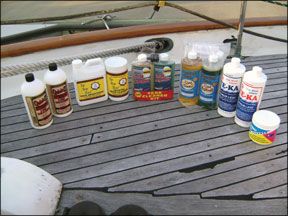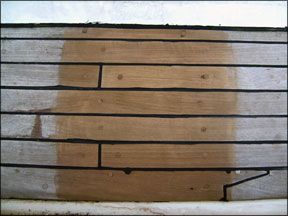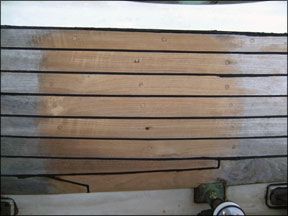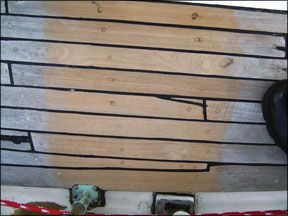In March 2008, we tested one-part teak cleaners to see which ones eased the burden of maintaining teak decks without being too harsh on the wood, applicator, or environment. In this report, Practical Sailor follows up with an evaluation of two-part cleaners and how they compare to one another and to a top pick from the one-part test.

Photos by Frank Lanier
Each of the cleaning kits we tested this go-round comprised two parts. The first part was a cleaner designed to remove the bulk of the grit and grime. The second part was typically a brightener, however in some products, it also provided additional cleaning or was simply a neutralizing agent for the first part.
Most chemical teak cleaners are overkill for regular maintenance of teak. For frequent cleanings, we suggest using a soft-bristled brush or scrubbing pad and a mild detergent-or skip detergents altogether and use only fresh or salt water (as many advocates of natural-looking teak do). A good scrubbing method is to go across the wood grain, rather than with it; this removes dirt and grime without removing the teaks soft wood. For tips on teak care from industry experts, check out the online version of this article at www.practical-sailor.com.
There are times when a serious teak cleaner is called for-like in preparation for applying a wood finish or before spring commissioning. But which one best suits your needs?
What we tested
Testers applied five two-part cleaners for this test. Four of these were liquids: Amazons Quicki-II Teak Cleaner, Nautical Ease Teak Cleaner and Brightener, West Marines Teak Cleaner and Brightener, and TE-KA Teak Wood Cleaner by Marinetex. Tip Top Teak combines liquid and granular powder parts.
To get an idea of whether using a two-part product is worth adding extra steps to the cleaning routine, we compared the five test products to Iosso Teak Cleaner, one of the top picks from our evaluation of one-part cleaners.

We also evaluated three one-part cleaners that were received too late to participate in the March 2008 test: TCL 200 Teak Cleaner Liquid and TCP 100 Teak Cleaning Powder from Teakdecking Systems and Yacht Shine Teak Cleaner from Capt Johns Boat Brite Group. See “Test Update” on page 24 for the scoop on the latecomers.
How we tested
Each teak cleaner was applied to a section of weathered teak decking aboard our test boat, a 1978 Union 36 docked in the Chesapeake Bay area. The boats deck, which is exposed year-round, had been previously cleaned using a deck brush and fresh water eight months prior to the test.
Testers applied each product following the manufacturers instructions. Because some of these products are rather harsh, wearing appropriate protective clothing and eyewear is a must.
All of the test products were effective cleaners, so other evaluation points became important to picking winners. We rated each on its ease of use, including mixing, application, special precautions, and dwell time; eco-friendliness/harshness, based on the information provided by the makers; effectiveness of the brightener; price; and odor. As in our one-part test, composite scores were too close to indicate Best Choice overall. However, the testing did narrow the field to a choice of products that best meet specific needs or preferences.
Amazons Quicki II
Amazon, part of the New Jersey-based Marine Development Corp. (MDR), offers a full line of marine cleaners and maintenance products, including inflatable boat products, teak care, specialty products, and fuel additives.
We tested the companys Quicki II two-part Teak Cleaner, which Amazon touts as being environmentally safe. It has no caustics or acids and is non-butyl, so it wont harm fiberglass.
The Quicki II kit includes a scrubber; a cleaner for deep stains, grease, and grime; and a secondary agent with surface cleaners and brighteners. The application requires no mixing, but both parts 1 and 2 must be “agitated” with the supplied scrubber before being left to sit and then rinsing. The combined dwell time can be as long as 25 minutes.
Testers noted that the Quicki II
Part 1 had no chemical smell, but Part 2 had a mild chemical smell.
Bottom line: Quicki II worked well with minimal scrubbing. Its biggest drawback is that the 25-minute dwell time stretches out teak cleaning sessions, but that is balanced by its eco-friendliness.
Nautical Ease
Nautical Ease is manufactured by Nautical Technologies Inc., which offers a full line of marine maintenance products.
Nautical Ease Teak Cleaner and Brightener is formulated to quickly clean and brighten badly oxidized teak, and it does just that with powerful chemicals. The Part 1 cleaner contains caustic soda (sodium hydroxide), which can burn skin, and the Part 2 brightener and neutralizer contains phosphoric acid (an irritant to eyes and mucous membranes)-not exactly fun to play with.

Both parts had a moderate chemical smell, testers noted, and the directions recommended keeping the products away from varnished and painted areas as well as any gelcoat. Included in the kit are a pair of rubber gloves, a small brush, and a flip-top cap. The Nautical Ease is applied with the supplied brush, no mixing is required, and the dwell time is a quick 5 minutes.
Nautical Ease started lifting off dirt almost as soon as testers applied it and cleaned its section well.
Bottom line: The short dwell time is a plus; however, Nautical Ease is one of the more toxic two-part cleaners tested and the need to keep it clear of varnish, paint, and gelcoat is a con.
West Marine Heavy-Duty Kit
Retail giant West Marine advertises its private-labeled teak cleaner for badly stained or weather teak. The two-part kit, made by Snyder Manufacturing, includes a cleaner and a neutralizer.
While the instructions claim that the product will not harm seam compounds, they do caution that it may damage gelcoat, paint, and metal surfaces. Its active ingredients also can be harmful to humans: Part 1 includes potassium hydroxide, an eye and skin irritant, while Part 2 contains oxalic acid, which is a poison and an eye and skin irritant. Testers reported that both parts had a moderate chemical smell.

The West Marine kit began powering away dirt and stains almost immediately. Users should apply the West Marine cleaner using a deck brush with synthetic bristles, according to the directions. The only “dwell” time is the wait while the area darkens, an estimated 3 to 5 minutes, before rinsing and applying the neutralizer.
Bottom line: A short dwell time is always a plus, and the West Marine cleaner produced the most uniform appearance of the cleaners evaluated. That being said, its also a fairly toxic product.
TE-KA Teak Wood Cleaner
TE-KA maker Marine-Tex, part of the Illinois Tool Works Inc. family of companies, manufactures cleaners, adhesives, and epoxies for the marine industry. The TE-KA two-part cleaner was the only scrubless product in this test.
The TE-KA cleaner and neutralizer had only a moderate chemical smell; however, warnings abound on both containers about their extremely corrosive nature. With sodium hydroxide and phosphoric acid as their active ingredients, both are labeled as being able to cause severe eye and skin burns and respiratory tract irritation.
While theres no mixing and not much of a dwell time, there are several precautions users must take when applying TE-KA. All adjacent surfaces must be masked before applying the cleaner with a rough pad or low-bristled brush. Also, the manufacturer warns that if any of Part 1 is spilled, it should be immediately neutralized with Part 2 and rinsed. But most inconvenient is the fact that TE-KA cannot be left on caulk seams for more than 3 to 4 minutes before it must be neutralized. That means a full deck would have to be cleaned in small sections.
The TE-KA showed signs of powerful cleaning action immediately, and the short dwell time was a plus. Unfortunately, having to treat it like the acid-blood from one of the creatures in “Alien” doesn’t make it very user friendly.
Bottom line: It works great, but wed opt for one of the less toxic products.
Tip Top Teak
Tip Top Products, based in Mississippi, markets a line of teak care products, including cleaners and sealers. Tip Top Teak Crystal cleaner and brightener is formulated to tackle large jobs like a deck.
Painted surfaces, fiberglass, and anodized aluminum should be masked off before Tip Top is applied. The primary ingredient for the cleaner, which forms a caustic solution when mixed with water, is 2-Butoxyethanol, an eye, skin, and mucous-membrane irritant. The brightener contains phosphoric acid, which can burn skin and irritate the respiratory tract. The deck-cleaning crystals had a mildly astringent odor, while the brightener had no odor, testers reported.

To apply, the Tip Top crystals are sprinkled liberally over a wet deck and let sit for 10 to 15 minutes, but the area should not be allowed to dry. A solution of 1 cup cleaner and a half-gallon water is used to keep the area wet. Following the dwell time, the area must be scrubbed and the brightener applied. It must be diluted with water and allowed to soak for about 5 minutes after application, then scrubbed and rinsed.
The cleaner worked well (possibly aided by the abrasive scouring action of the crystals) while the deck brightener began to visibly lighten the wood almost instantaneously when applied.
Bottom line: Tip Top cleaned well, but the combined 20-minute dwell time, the harshness of the solution, and the need to constantly monitor its dryness are drawbacks.
Iosso Teak Cleaner
Our measuring stick in this test for comparison to one-part teak cleaners, the Iosso Teak cleaner is part of the Illinois-based companys line of innovative, environmentally responsible cleaning products for the marine and RV markets.
The Iosso is a powder cleaner designed to remove dirt, black algae, and mildew stains without harsh chemicals. A 16-ounce container makes 4 gallons of cleaner; one scoop of powder makes a quart when combined with water.
We don’t really know what Iossos active ingredients are. They arent mentioned in product labeling, and the MSDS simply states “Trade Secret” for its ingredients. Iosso does claim that the cleaner emits no harmful vapors, is biodegradable, and non-toxic; wont harm vinyl, canvas, carpet, metal, painted areas, fiberglass or plastic; and is gentle to skin. Neither the powder nor solution had any noticeable smell during application.
After mixing the cleaner and allowing it to dissolve, the solution can be applied to any horizontal or vertical surface and left to dwell for 10 minutes, or longer. The area must be kept wet with the solution, and the product literature states that extremely weathered wood may require a second application.
Testers were surprised in the 2008 test and again in this update that despite its gentleness, the Iosso is a top performer, even against the two-part cleaners.
Bottom line: The least harsh product in this test group, the Iosso was fairly easy to apply and was the most economical of the entire test group-even if a second application is required. Being a one-part product, it also requires fewer application steps.
Conclusion
Based on the harsh chemicals and toxic nature of most of the two-part cleaners, we consider them to be the “nuclear option.” Wed turn to them only for badly soiled teak that doesn’t respond to one-part cleaners. They should not be used for routine maintenance, in our opinion.
All of the two-part cleaners did the job and left a clean, bright deck. For a bargain buy, we recommend Nautical Ease Teak Cleaner and Brightener. If you prize brute cleaning power and quick results over being “green,” the West Marine Heavy-duty Teak Cleaner is a good choice. It cleaned as well as TE-KA, but was slightly less harsh and didnt have such dire warnings about use near other surfaces. For those boat owners who may be cleaning teak below decks or who prefer an eco-friendly, less caustic cleaner, we recommend Amazons Quicki II.
Although its a bit like comparing apples to oranges, we still like the Iosso best overall, even compared to the two-parters. Its safe to use, eco-friendly, and inexpensive, yet it cleans teak amazingly well.






































